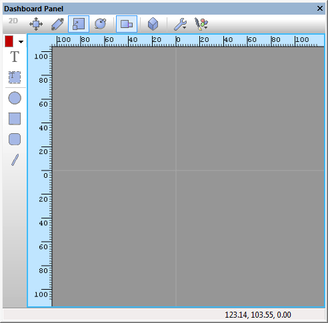Difference between revisions of "Role of the Dashboard Panel"
| (6 intermediate revisions by the same user not shown) | |||
| Line 1: | Line 1: | ||
<sidebar>Sidebar: Controlling Electronic Devices With Flowcode</sidebar> | <sidebar>Sidebar: Controlling Electronic Devices With Flowcode</sidebar> | ||
| + | [[File:Gen Dashboard Panel 01.png|328x323px|right]] | ||
The Dashboard Panel provides a framework on which to load Flowcode components and is designed to show the representation of abstract components such as dials and meters during simulation. | The Dashboard Panel provides a framework on which to load Flowcode components and is designed to show the representation of abstract components such as dials and meters during simulation. | ||
| − | The [[Dashboard Panel]] and [[System Panel]] are both designed to compliment each other, the Dashboard Panel is a 2D workspace to display and simulate controls, such as buttons, switches, dials, knobs and sliders as well as readings such as meters, scales and digits such as temperatures, times and measurements etc. | + | The [[Dashboard Panel]] and [[System Panel]] are both designed to compliment each other, the Dashboard Panel is a 2D workspace designed to display and simulate controls, such as buttons, switches, dials, knobs and sliders as well as readings such as meters, scales and digits such as temperatures, times and measurements etc. |
| − | The Dashboard Panel can also produce components and simulate flowchart programs with ease, although it is not as versatile compared to the System Panel it can still be done effectively. | + | The Dashboard Panel can also produce components and simulate flowchart programs with ease, although it is not as versatile compared to the System Panel it can still be done accurately and effectively due to quick and easy easily accessible built-in rulers to quickly make accurate changes with ease. |
The Dashboard Panel can still be used to create powerful systems and applications on its own, although it works best in conjunction with the System Panel. | The Dashboard Panel can still be used to create powerful systems and applications on its own, although it works best in conjunction with the System Panel. | ||
Latest revision as of 12:12, 18 July 2013
<sidebar>Sidebar: Controlling Electronic Devices With Flowcode</sidebar>
The Dashboard Panel provides a framework on which to load Flowcode components and is designed to show the representation of abstract components such as dials and meters during simulation.
The Dashboard Panel and System Panel are both designed to compliment each other, the Dashboard Panel is a 2D workspace designed to display and simulate controls, such as buttons, switches, dials, knobs and sliders as well as readings such as meters, scales and digits such as temperatures, times and measurements etc.
The Dashboard Panel can also produce components and simulate flowchart programs with ease, although it is not as versatile compared to the System Panel it can still be done accurately and effectively due to quick and easy easily accessible built-in rulers to quickly make accurate changes with ease.
The Dashboard Panel can still be used to create powerful systems and applications on its own, although it works best in conjunction with the System Panel.
